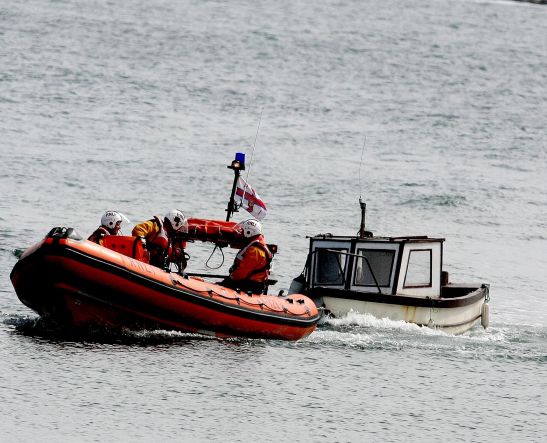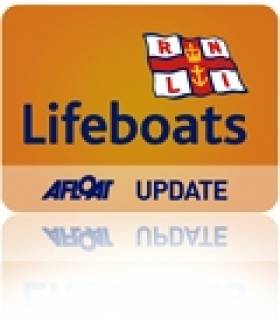Displaying items by tag: Lifeboat
999 call prompts rescue of six men off Swansea
Swansea Coastguard called out the Mumbles Coastguard Rescue team and requested the launch of the Mumbles RNLI inshore lifeboat.
The lifeboat upon reaching the drifting vessel discovered the craft was carrying six men of chinese origin, it was taking on water due to the boat having no bung, and there was no lifesaving equipment whatsoever.
The South Wales police were alerted to the incident and despatched a unit to question the men. The six men are being interviewed by the police.
Dai Jones, Watch Manager, Swansea Coastguard said:
If we had not been alerted to this drifting vessel by the member of the public, this incident could so easily have had a different outcome.
The vessel was drifting towards where the tide flows extremely fast and it would have carried this craft and it's six occupants to extreme danger.
As the vessel was taking water and not a lifejacket between them, we could easily have been looking at a fatal incident.
Lifeboats Rescue Man Overboard off Antrim Coast
On a busy Sunday for RNLI lifeboat crews off the north Antrim Coast both Red Bay and Portrush RNLI lifeboat crews launched at 9.22am this morning to reports of a vessel in difficulty with two people onboard off Sheep Island at Ballintoy.
The 16 foot fishing boat got into difficulties when an anchor went down and a crewmember from the vessel bent over the bow of the boat in an attempt to retrieve it. He was caught by a wave and pulled into the freezing water.
When the lifeboats arrived on scene the man had been recovered onto the vessel by the other crewmember. Conditions were poor with a force five in evidence and a big swell. Both men were suffering from the cold and were in shock. The vessel was clearly in great difficulty and the two men were transferred onboard the Portrush all weather lifeboat while Red Bay RNLI towed the vessel back to land. A waiting ambulance met the casualties at Ballycastle.

Commenting on the rescue Red Bay RNLI helm Paddy McLaughlin said, “These two men were extremely lucky today. One man had already entered the freezing water before getting back on the boat and they were both in need of medical assistance by the time we had reached them.”
The rescue operation lasted for three hours and was the second major rescue for the RNLI in the area that morning. Portrush RNLI inshore lifeboat crew rescued two men from the sea while their all weather lifeboat assisted Red Bay with the Ballintoy callout.

Additional report from MCA:
The emergency 999 call was made at 9.15 this morning alerting the marine emergency service and that the cruiser with two people on board was in extreme difficulty and without power.
The Coastguard immediately relayed a mayday signal into the area to alert other vessels to the on going emergency.
The Portrush and Redbay lifeboats were also asked to launch and a rescue helicopter was initially scrambled from the Royal Naval Air Station at Prestwick, however by this time the man had been recovered to the vessel and it was stood down. His colleagues on board the cabin cruiser indicated that he was very cold but there were no visible injuries and that he was slowly warming up, but they remained without power as a rope had been caught around its propeller and were experiencing very heavy weather. The Portrush all weather lifeboat picked up the man who gone into the water and a colleague and brought them will all speed back to Ballycastle. The Redbay lifeboat is now bringing the vessel under tow back to Ballycastle.
Meanwhile a further call was taken from Portrush promenade where a member of the public had spotted two people in the water shouting for help. Both were drunk and had been caught in the rip tide off West Strand. The Coastguard began broadcasting into the area immediately requesting vessels to go to his assistance and the Portrush inshore lifeboat was on scene very quickly and recovered both people to the lifeboat. An ambulance was requested and the lifeboat was met by the Coleraine Coastguard Rescue Team and paramedics.
Alan Pritchard, Duty Watch Manager at Belfast Coastguard said:
“It is clear that the weather is going to be somewhat rough today with rain forecast. We are asking the boating public and those who will be visiting the coastline to take that extra bit of care. Make sure you have some communication with you, and of course if you go afloat wear a lifejacket! The two men who went into the water whilst under the influence of drink are very poorly in hospital, and we cannot stress enough how dangerous it is going into the sea whilst drinking.”
Ballycotton Lifeboat Launched for Red Flares
Castletownbere RNLI Gets Go-Ahead for New Station
The announcement was made during a visit of architect Gordon J. Philip and RNLI Divisional Inspector Martyn Smith to the proposed site of the new lifeboat station in Castletownbere, County Cork. The station is being built on reclaimed land, which was given to the charity by the Irish Government. The cost of building the station will be in the region of €600,000 and will include crew changing facilities, meeting and training rooms and a workshop. There will also be a lifeboat shop where members of the public can purchase lifeboat souvenirs.
All materials to be used in the building are being sourced from Irish suppliers and the station has been designed to the highest standards. Work is scheduled to begin in September 2010 and due to be completed in thirty weeks.
The station has been operating out of temporary facilities on Dinish Island and it has meant that the lifeboat crew, who are largely based in the town, have had to travel to there and then reach the lifeboat by boarding boat. The new arrangement will see them assemble at the station on the quayside and board the lifeboat directly from a pontoon, which will cut launch times by up to five minutes.
Commenting on plans for the new lifeboat station Brian O’Driscoll, Coxswain with Castletownbere RNLI said, “This lifeboat station will make a huge difference to the crew. We expect to be able to cut around five minutes off our lifeboat launching time, which will mean a faster response time to emergencies. Paul Stevens, Deputy Second Coxswain added that “with the lifeboat being directly accessible from the pier we will be able to land casualties ashore, allowing us to handle serious situations with sensitivity and privacy.”
Scottish architect Gordon J. Philip has already designed seven RNLI lifeboat stations but Castletownbere will be his first in Ireland. Gordon who is from a fishing family is a former RNLI volunteer with Macduff RNLI, having spent four decades involved as lifeboat crew and station management. He is very aware of the need for the lifeboat crew to have proper facilities and for the station to be an important and aesthetically pleasing part of the community it is housed in. Gordon said, “I want this lifeboat station to be a landmark in the town for all the right reasons. We will be building on land that didn’t even exist last year and giving the lifeboat crew of the Annette Hutton a sheltered and secure home at the front of this beautiful town.”
At the formal opening of the RNLI lifeboat college in Poole in 2004 Queen Elizabeth and The Duke of Edinburgh met the Castletownbere crew members and departed the College on Castletownbere’s lifeboat Annette Hutton.



























































